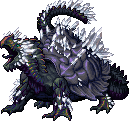Viewing Faultline

Hardiness: 180
Appearance: 6
Emerged: 5:00 30.06.2024
Matured: 22:25 01.07.2024
Monta Selo is a sedentary, cave-dwelling species found in deep caverns, usually near underground lakes. The bioluminescent patches on its shell attract both Cielarka Cimos and Senvida Nagantos, and the crystalline growths act as natural camouflage as the Monta Selo waits for its preferred prey, Ombra Vespertos, which feed upon the insects and fish. Though generally solitary, Monta Selos gather in large numbers during their brief breeding season, which occurs only once every four years in late winter. Males build nests of bioluminescent moss and pace around them, showing off their crystals to potential mates. Females will choose a male by stepping onto the nest. Once the eggs are laid, they are covered with more moss and left to hatch on their own. As Monta Selos have no natural predators, they can live for a very long time, and some documented individuals may be well over a hundred years old. They are generally docile when approached, with females displaying quieter dispositions, and are strong enough to carry a human on their back, although their studded carapace and slow speed make their use for transportation impractical.
The creatures that dwell in this rather desolate world still display some diversity in appearance, eating habits, and social behavior. Whether they have fur or feathers, skin or scales, their unique genetic makeup allows for a variety of colors and markings within each species. Despite limitations in food sources, herbivores, omnivores, and carnivores are all present in the food chain, and each species requires specialized care within a laboratory. Although the artificial setting of housing units and breeding pods precludes most opportunities to study true interspecific behavior, the interactions within and between species has been studied extensively in the wilderness by scientists daring enough to venture beyond the outpost’s walls.
Creature Notes
- Curious. M. Selo ID jdUZg ("Faultline") has uniquely high hardiness upon becoming a juvenile, just like O. Vesperto ID dmPio ("Luceros"), and also similarly to him, is a G2 bred in captivity.
- Faultline has a higher hardiness than other juveniles of similar ages, even with less exposure. Are G2s perhaps inherently more hardy, or at least more sensitive to early exposure than G1s?
- Further review leads me to discover that both Faultline and Luceros are recorded as having at least one parent with a hardiness score of nearly 80. Heritable, perhaps?
